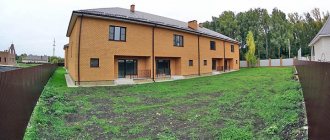Currently, in Russia there are a huge number of self-built buildings for various purposes. Including those who, in principle, cannot be legitimized.
This usually applies to cases where a tenant who does not have rights to the site, or a complete stranger, specifically erects a building for certain purposes, or the developer of a private house uses the site for other purposes.
There are also common cases when a house (or house extensions) are recognized as unauthorized construction because they are dangerous for living, as they do not comply with construction standards and regulations.
Unauthorized construction of various structures in all regions of our country is a long-established fact, including due to the imperfection of legislation on this issue.
Is it possible to legalize squatter construction? Yes. And although the legalization of buildings, at first glance, seems to be a difficult task that will require a serious investment of time and effort, you should not despair, because, as you know, any problem can be solved in your favor...
What is considered squatter construction?
Self-construction is real estate built on a site in violation of its intended use, or built in the absence of the necessary permits for its construction. This term also includes all buildings and structures that do not meet building codes.
If a property is recognized as a self-construction, the following restrictions are imposed on it:
- in registration of property rights;
- in the use of real estate;
- in the ability to carry out rental and purchase and sale transactions.
In accordance with the law, unauthorized construction also includes various buildings and structures, the construction of which, for various reasons, was not agreed upon with the administration of the locality within whose borders they are located.
When should you go to court?
Important! Legalization of unauthorized construction through the courts is a common phenomenon, since many citizens face refusal. You can get a refusal at various stages - both when contacting local authorities and Rosreestr.
The only way out when receiving a refusal at any stage of the administrative procedure is to go to court (judicial practice shows that the chance of receiving a positive decision is quite high). To do this, to the above documents you need to add a statement of claim, a receipt for payment of the fee, a copy of the refusal, as well as other documentation obtained during interaction with various structures (BTI, the department of architecture and Rosreestr).
The amount of the fee, as well as the court in which the application will be considered (world or district) depend on the cost of the building. To find out, contact a specialized company that conducts this category of research and prepares conclusions.
If, based on the results of consideration of the statement of claim, the court makes a decision positive for the applicant, the citizen will only have to contact Rosreestr or the MFC. Registration of property rights in this case occurs on the basis of a court decision.
Signs of unauthorized construction (squatter construction)
From the point of view of the law, in order for a house to be recognized as an unauthorized construction, it is sufficient that it meets one of the following criteria:
- The house was built on a plot (territory), the ownership of which was not properly registered;
- The building (structure) was built on a site (territory) in violation of its intended use (where such construction is prohibited);
- The construction of a residential building (and other buildings) was carried out without coordination with the authorized authorities (for example, there is no construction permit or commissioning certificate);
- The construction of the building was carried out in gross violation of town planning standards, GOST and SNiP rules, fire safety and other mandatory requirements for this type of building.
Each of the above violations is a serious cause for concern for the owner. If the building is recognized as an unauthorized construction, at best, he will not be able to freely dispose of his property (rent, remodel, sell, etc.), at worst, everything may end with the termination of ownership rights and the physical demolition of the illegal building.
Therefore, it is in the interests of the owner to solve this problem as quickly as possible. And make sure that the house (and other buildings) do not fall under the criteria of unauthorized (illegal) construction.
Obtaining ownership rights voluntarily
So, in order to obtain ownership of a building on a voluntary basis, it is necessary to go through a number of stages. First of all, you will need to prepare technical documentation (for this you need to contact the BTI). Then the package of documents along with the application is submitted to the municipal authorities (as a rule, this issue is dealt with by the architecture department, construction department or town planning committee).
Local authorities must issue an urban planning plan for the land plot (GPZU), a permit and a conclusion, which will indicate that the building meets all requirements. After resolving all issues with local authorities, you must again visit the BTI to formalize technical requirements. plan.
The next stage is to contact Rosreestr (or the MFC) to register property rights. If everything is done correctly, the registration authority will register the object and provide the applicant with documents confirming ownership of the object.
Types of unauthorized buildings
According to the law, unauthorized structures are divided into two types:
1st type
When the owner (tenant) of a plot has made unauthorized construction of a property without having permits.
Most often these are residential buildings on personal plots, as well as small objects built on lands, for some reason, without proper supervision by the authorities, as well as small stalls, kiosks, shops built without appropriate documentation.
What is the punishment for self-construction?
Unauthorized erection of a structure leads to the need to apply certain penalties for citizens:
- when constructing a non-permanent structure on a site that does not belong to a person, a fine of 1 thousand rubles is imposed;
Demolition of unauthorized construction.
- if a house is being built on its own territory, but there is no prior permission for this process, then the fine starts from 2.5 thousand rubles;
- if a structure is built on land that is not intended for these purposes, then such an object will certainly be demolished, and all expenses for this process will be compensated by the violator.
Important! The demolition of a building is also ordered if, by its design and parameters, it violates basic building codes and fire safety requirements.
How to legalize unauthorized construction?
There are only 2 ways to legalize self-construction:
- administrative method;
- through the court.
Legalization of a house by administrative method
The essence of this method is that all the papers required by law for real estate are issued retroactively: this is a construction permit, an acceptance certificate from the state commission, and others.
Sometimes owners use another method: they send a request to the special Commission on Unauthorized Construction with a request to “preserve” the constructed object. If the decision is positive, it issues a construction permit, as well as all the necessary documents to put the facility into operation.
It makes sense to use the option of requesting the Commission only if we are talking about properties intended for single-family residence. True, the percentage of approval by the Commission differs for different types of houses. So, if you need to legitimize a wooden house located in a dacha or gardening partnership, you will most likely receive a positive answer. And if it’s a brick or concrete house, then depending on your luck.
Legalization of a house through court
In order for the court to side with the owner, he needs to prove that the property he built on his site does not pose a threat to the life and health of people, and in no way violates the legitimate interests of the other owners (neighbors), and in addition does not infringe on the rights of third parties persons
When going to court, it is important to correctly draft a statement of claim. It should indicate your rights to the land plot, as well as describe in detail the process of constructing an object recognized as unauthorized construction.
Advice: Keep in mind that the court shares the responsibility of owners and developers. If a house recognized as an unauthorized construction was built not by the owner of the site, but by an hired developer, be sure to indicate this in the statement of claim. In this way, you will strengthen your position (which you may not have known about the violations) and increase the chances that the court will side with you.
Try to collect as much evidence as possible. During the trial, indicate why the house was recognized as an unauthorized construction (for example, because a building permit was not obtained) and try to indicate that the house was built with a minimum of violations of standards (ideally, of course, without them).
You must prove that the house de jure falls under the criteria of unauthorized construction, but in fact it is not, since during its construction there were no violations of building rules and regulations (or were insignificant), and the house itself does not pose a danger to people, and does not violate the rights and interests of 3rd parties.
If the property was built on your own, describe to the court what procedures were followed to register it. Have you applied to the relevant authorities to obtain a construction permit or to obtain a certificate of putting the facility into operation? If a representative of the relevant organization refused to provide permission, be sure to describe this fact.
Times don't choose...
Four years ago, a legislative campaign on “AWOLs” was carried out; the adopted package of documents differed from the current draft in being more loyal. And the new laws provide for the possibility of legalizing illegal construction. But if the Civil Code is improved towards prohibitions, any construction not taken into account by the State Planning Committee will one day be declared illegal, i.e. deprived of the right to exist.
This is approximately what guided the Presidential Council for the Codification and Improvement of the Civil Code, giving a negative assessment of the government’s proposals for new laws. In particular, the proposal to pay compensation to the new owner when purchasing an illegal structure caused disagreement. And the seizure of land property during the discussion of the project was considered by the council to be an infringement of human rights, an unfounded measure.
What is an “extension” and why should it be legalized?
An extension is a part of a building erected on the local area after the construction of the house has been completed and it has been put into operation, that is, this area was not included in the plan . Any documentation for the house should be put in order in a timely manner, otherwise you will not be able to take any legal actions with the property. The legalization of the extension is carried out with the help of a court in civil proceedings. You file a claim and the local municipality is the defendant.
Will unregistered buildings be demolished?
According to tax officials, unregistered housing is a selfish way to hide from paying taxes. After all, if there is no property right, then taxes will not be collected. But their non-payment does not necessarily imply selfish intent. Due to failures in the Federal Tax Service system or for other objective reasons, payment receipts may not be received by the owner, but even in this case, punishment cannot be avoided.
What punitive measures has the state prepared for non-payers?
Civil servants have not yet decided on the type of punishment.
Some talk about the demolition of illegal housing, others propose more humane methods. Alexander Chuprakov, deputy chairman of the regional government, said that amendments to the Tax Code are being prepared. If they are adopted, the fine for unregistered housing will include a tax based on the cadastral value of the site, multiplied several times. According to the official, no one will want to receive such a bill, so the problem will be quickly resolved. According to statistics from the regional government, in the Moscow region today the number of unregistered housing is less than 30% of all buildings. Judging by the comments of representatives of various authorities, there are no plans to bring the matter to demolition. But according to the law, unregistered real estate is a self-construction, so the risks for its owners are high.
If you remember how they fought against illegal stalls in the capital, then the owners of such buildings should think twice.











